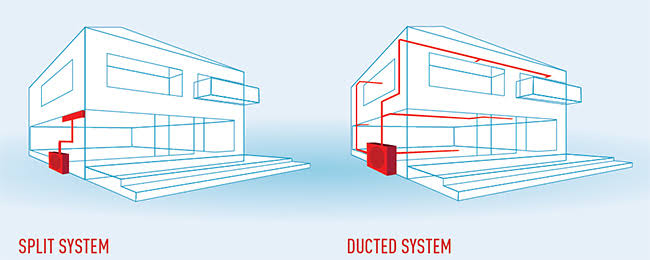
The idea of a centralised ducted AC system is attractive in some sense because the ducting can all be hidden away and routed to a centralised AC unit that could in theory by installed on your roof (assuming it is possible to install in your house). However ducting has many downsides compared to split systems that not many people are aware of:
- Leaking: Ducting in your roof will develop weak spots and leaks over time, this will not only let heat out it can allow dust (and thus mould and bacteria) in; people with old ducts will notice a musty smell when the ducts initially fire up, even though ducted systems have filters they are not perfect. It is also virtually impossible to clean ducts once they are contaminated.
- Thermal losses: Ducting insulation cannot be too thick or the ducting will not fit in the roof and wall cavities, it is at most R1-2 level insulation. This means around 30% + of the heating and cooling energy will be lost in the ducting significantly reducing efficiency; in terms of the amount of heating or cooling energy delivered to a room (preferably occupied) per unit of input energy.
- Poor control: Ducted heating can be zoned but it rarely has advanced feature such as the ability to detect if a person is in a room (something the better split system AC units can do) this means that ducted heating and cooling tends to heat and cool much more of the house than is necessary; reducing efficiency as measured by heating and cooling delivered to occupied rooms (probably the best measure of efficiency).
- Poor airflow and mixing: Ducted systems (especially those with vents mounted in the roof) are not good at mixing warm air in a room and instead tend to result in stratified air with hot air near the ceiling and colder air nearer the floor i.e. where people are. They also tend to blast hot or cold air in one location when the ideal is something like a gentle breeze. Gentler airflow and mixing can be delivered my split system AC which can angle the airflow in multiple directions with the warm or cool air emanating from a wider vent. The Daikin US7 is also capable of producing Condura airflow which evenly distributes cool air by directing airflow over objects in the room to the opposite wall.
- High power use of ducting fan: Central heating/cooling requires quite a powerful fan to force the air through all the ducts, up to 500W for some central heaters. This high energy consumption adds up if you have you heating/cooling on for a long time. To give you a comparison, a US7 can use as little as 600W to provide heating and cooling when in steady state operation, whereas the central heating fan is just used to push the hot or cold air around your ducting system.
So as you can see there are quite a number of disadvantages to ducted systems over split systems. The only real advantage to ducting is that the centralised AC unit has less of a footprint than the split system outdoor units; when you weigh that against the advantages of split systems which have: much higher efficiency, cleaner air, smarter features and a better comfort level it is hard to argue the smaller footprint is worth it.
Ultimately heating and cooling is about providing a comfortable environment in the home. Which heating/cooling system you choose is up to you but it's good to know the pros and cons of each before you spend your hard earned money on a system that might not be what you hoped for, especially if there is something that is better able to make your home environment comfortable and good to live in.

